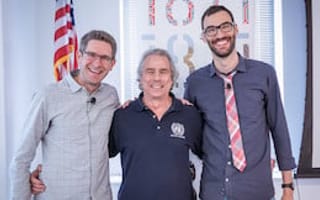
The inherently slow nature of software development is one of the biggest challenges technology companies face. Even at a startup operating under the minimum viable product model, a working prototype can sometimes be months — or even years — in the making before potential users lay hands on it.
This kind of up-front investment in a particular design can strongly influence how a company responds to customer feedback. Instead of scrapping features that customers don’t respond to, companies may end up dedicating extensive resources to salvaging them or, worse yet, deciding that the customers are wrong.
Developed by Alphabet’s GV venture arm, the design sprint approach aims to circumvent these issues by taking products from idea to prototype in a single workweek. Slack used the approach to revamp its customer onboarding experience, as did robotics startup Savioke in designing the user interface of its autonomous delivery robot for hotels. Blue Bottle Coffee used it to revamp its e-commerce platform.
Sprint's Chicago roots
Although developed at GV's headquarters in Silicon Valley, the design sprint has a strong connection to Chicago tech. GV Design Partner John Zeratsky, who was part of developing the process, got his start in tech as a user experience designer for Chicago-based FeedBurner. Zeratsky joined Google following its acquisition of FeedBurner and landed at GV design in 2011. At GV, he worked with Design Partner Jake Knapp to refine the design sprint method.
But Knapp’s original idea for a productivity-boosting approach to design was actually inspired by another Chicago startup.
“I was working at Microsoft when I started to get interested in personal productivity and team productivity, and I read this book, 'Getting Real,' by 37signals, which is now Basecamp,” Knapp said. “I couldn’t unsee it, so a couple of years later I left Microsoft, joined Google and found that at Google there was a real appetite for experimenting with team processes.”
Drawing on "Getting Real," which emphasizes building software quickly, simply and with the end user in mind, Knapp decided to take that line of thinking one step further: What if you could bring products in front of customers before those products actually existed?

The weeklong roadmap from idea to prototype
What Knapp and Zeratsky (pictured above) came up with, along with their colleagues at the GV design team, is a five-day process that starts with an idea and ends with user testing. On Monday, the team discusses long-term goals and settles on a specific problem they aim to solve. On Tuesday, participants start sketching out ideas for what the product should look like. Wednesday is dedicated to picking one of these sketches, and Thursday is spent building the façade of a prototype.
The idea is to make the prototype realistic enough to understand how users interact with the interface without spending time on the underlying functions. The end result will usually look and feel like a real application, complete with text and design elements — but it doesn’t actually do anything.
During Friday’s testing, the entire team will watch users interact with the prototype to observe firsthand whether the design is working, and how it might be improved.
To Zeratsky, this rapid iterative approach is reminiscent of his early days as a layout designer for the University of Wisconsin at Madison’s student newspaper.
“Without really thinking about it, I had lucked into this environment where every day I got to design the paper, screw it up and make whatever mistakes I would make and learn from that experience,” he said. “The next day I could fix it. I learned a ton from that.”
As his career progression brought him to bigger projects with increasing degrees of complexity (culminating in the redesign of YouTube), Zeratsky started looking for opportunities to get back to a more nimble design environment.
At GV, he found one.
“As we developed [the sprint process] together, we found ways to use it with the companies in our portfolio, not just with the obvious design stuff like how a web page should look, but to really help them figure out key questions they had about their business,” said Zeratsky. “If we’re going to go into a new market, should we explain the product this way or that way? If we’re introducing a new product, should it have these features or those features?”

GV turns its eyes beyond Silicon Valley
Last week, Zeratsky and Knapp (pictured above) visited Chicago to meet with local startups and discuss their new book about the process. The pair said they were particularly impressed with the level of engagement they received after a presentation at BLUE1647 and the vibrancy of 1871.
“We’ve been to a lot of cities and seen a lot of those kinds of spaces, but I’ve never seen one that has such critical mass,” said Knapp. “You look at their board of the activities coming up, and it’s crazy.”
The entrepreneurship center’s combination of startups, investors and accelerator programs, added Zeratsky, creates the same kind of opportunities seen in Silicon Valley within the walls of a single building.
Although GV doesn’t yet have any investments in Chicago, the VC firm is increasingly turning its eyes beyond Silicon Valley.
“Chicago has been on our radar, and we thought it was a great opportunity to come, not with a specific agenda or really scouring for companies, but really starting to meet a lot of people here,” Knapp said. “We’re trying to start to raise the profile of GV a little bit and get to know people here.”
Images via 1871/Gregory Rothstein.
Have a tip for us? Send us a note or follow us on Twitter @BuiltInChicago.





.jpg)
.png)